Playground of the Apocalypse
by Shane O’Neill
The strand is ravaged by the storm that had raged for two days, uprooting weeds and hurling rocks huge distances along the beach. Large chunks of sand have been torn away by the sea, leaving small dunes and bunkers for us to traverse unsteadily. The sky is still a heavy grey and we have to squint through the watery haze of falling rain and fight against the fierce winds. Black clouds are reflected in the tumultuous waters and barren black mountains tower over us. Tiny mussels are clamped to these monoliths, holding on tight against the forces of nature. In this deathscape, the natural elements blend into something at once terrifying and awe-inspiring.
Sandra has stopped a few metres back to contemplate a strip of sea weed. As I make my way back to her, I am careful to avoid stepping on the remains of a huge crab arm, torn from its host and half-submerged in the sand, its pincer pointing skyward. She nudges the large strip of algae with her shoe. I have nightmare visions of it wrapping itself around us, dragging us down to cthulian depths. She is an avid Lovecraft fan and I can only imagine the terrors traversing her mind. She opens her mouth and I feel my body tense as I wait for her to evoke a maritime horror beyond my dull powers of comprehension–
‘Do you think I could make a bath with this?’ she asks, and I exhale, suddenly aware that I had been holding in my breath.
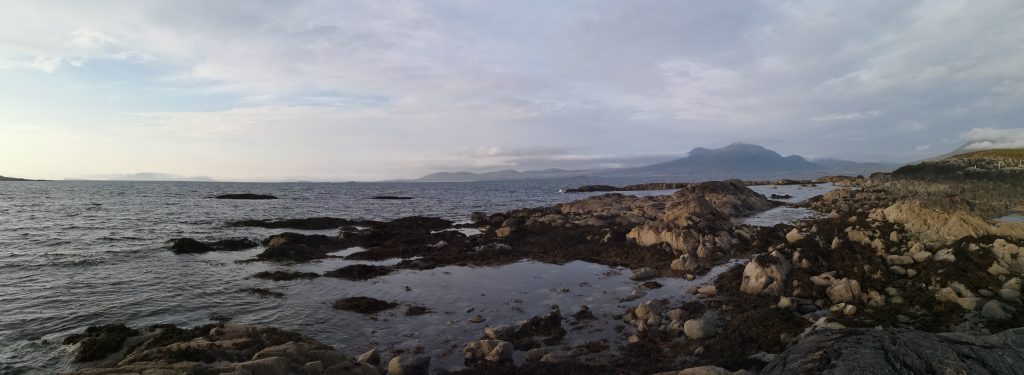
We had escaped to Connemara in March for a four-day trip. Desperate to flee the city, we rented a cottage for a weekend, with the intention of staying on an extra week should it be possible.
The first night was the most difficult. The house was freezing, having been unoccupied the previous month. The wind howled and we were awoken several times by an insidious breeze. The weather, however, cleared the following day, although there was no noticeable change in temperature. We became accustomed to building a fire at night and as the week progressed, the cottage warmed up. At first, it took hours of near-constant prodding to make a small flicker of flame respond and consume the fuel that we feed it. Now it only takes us minutes. There is a stack of turf in the garden, covered in netting and sticks, which our host, Helen, advises us to plunder at will. In her text, she cautions us not to disturb anything nesting within. Unsure how to interpret this cryptic message, I don a pair of gloves and Sandra holds open two bags while I fill them.
Although Helen’s house is less than a hundred metres from the cottage, we have not yet met our host in person, mostly due to the widespread fear of human contact that the pandemic is inducing. At the end of our first weekend we contact her, asking about the possibility of staying on a week longer. We have little desire to return to the city and face the pestilent hordes that we saw congregating en masse just days before. Helen agrees. As the week comes to an end, we write to her again, the day before the lockdown announcement, asking her what kind of monthly rate she can offer us. We explain that we are both budding academics with little money. Having presumably lost all her other customers to the virus, she is happy to come to a deal that suits all parties.
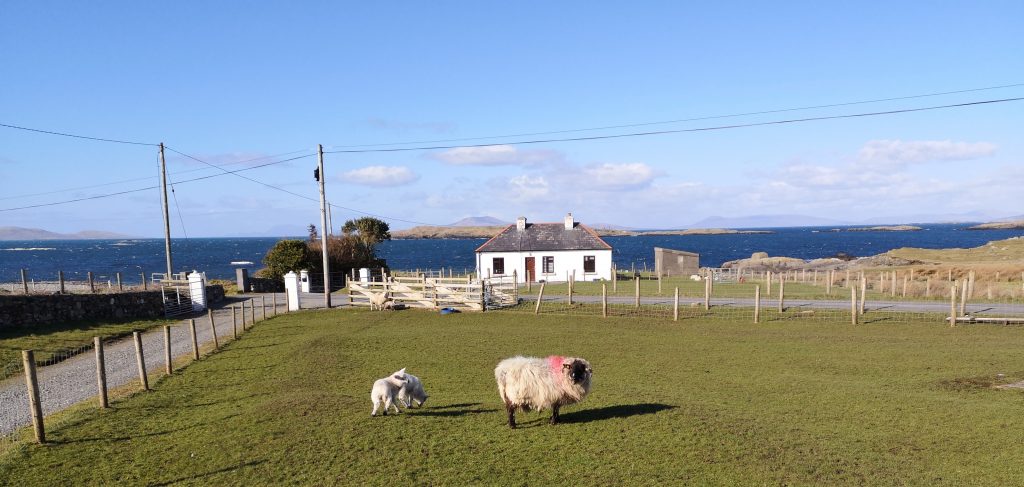
Sandra is eager to go to Connemara National Park which she had previously visited with her parents. We think it best to make use of the fine weather – Connemara (and the West of Ireland in general) being notorious for its unrelenting rain. At this point, we would have laughed had someone suggested to us that we would still find ourselves in Connemara twelve weeks later – laughed more had they suggested that there would be almost no precipitation throughout this lengthy stay (the exception being, of course, during the violent storm that was yet to come.)
Before setting out for Diamond Hill, the park’s main attraction, Sandra warns me that the incline is steep. Being both fit and young, I don’t think we will struggle. It is warm as we begin our ascent and we are soon sweating. There are many places to rest on the hill, and under normal circumstances, I imagine it is a pleasant excursion. However, schools and colleges have been closed for a week and increasing numbers of people now work from home. Despite our early start, hordes of people, now with time on their hands, are arriving at the park. Walking together in large groups, they seem oblivious to the notion of social distancing. They walk fast, faster than us and are soon closer than we are comfortable with. We are forced to take several tactical breaks on our ascent, stopping at inlets where we can give our pursuers a wide berth as they pass. Although probably safe in this outdoor setting, the constant flow of bodies disturbs us and we are relieved when we reach the summit. Here, we are met with a spectacular panoramic view of Connemara: the Twelve Bens mountain range, Kylemore Abbey, the surrounding marshlands and the dark Atlantic sea. However, the mass of visitors frustrates us and we vow from this point on to avoid tourist hotspots, unaware that within a week they will be closed and outside of our lockdown radius.
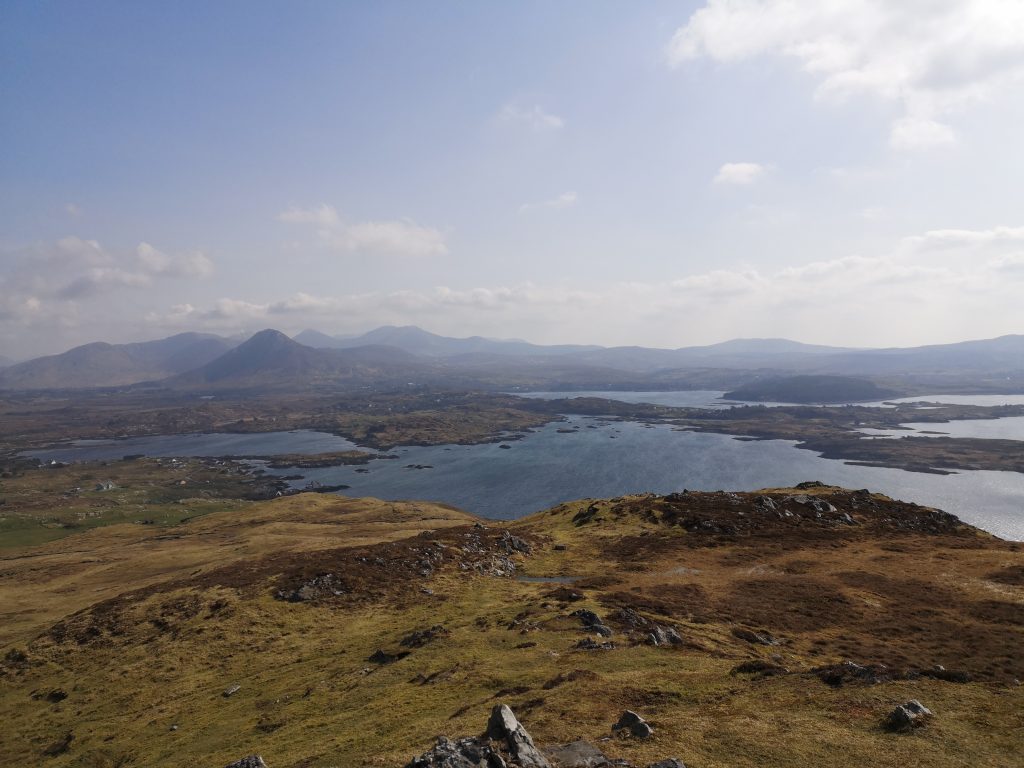
Back at the cottage, we prepare ourselves a hot whiskey (something we do far too frequently during the first weeks of our stay) and message Helen, asking her about other, less ‘touristy’ trails and hikes that we might be able to do during our stay. She suggests Letter Hill (a literal translation of the Irish Cnoc Leitreach), known better as Tully Mountain, situated on the outskirts of Letterfrack. After a quick Google search, we discover it is not far from the cottage and two days later, having recovered from our previous hike, we set off on a second excursion.
Unlike the National Park, Letter Hill has no designated car park, no signposts indicating where to begin the ascent, no other bodies leading the way. We drive the scenic route to the hill, not by choice, but because my Google Maps seems disoriented by the slew of unmarked roads. We are halfway up the hill before we realise it, driving on the edge of a cliff face with nothing to stop the car from plunging off the side should we make a wrong move. There is no clear way down and so we are forced to continue our precarious ascent, hoping not to encounter another vehicle. Houses have been built into the mountainside, and it is in one of these driveways that we eventually manage to reorient the car. Our descent is no less perilous and halfway down we find our path blocked by a horde of oncoming sheep, led from behind by a farmer in a red jeep. He has a wild air about him, his hair white and dishevelled, sporting a fashionably bright, yellow visibility jacket. We stop and wait for him and his sheep to pass. Sandra takes photos of the sheep as they make their way slowly around her Volvo, peering in at us with a mixture of fear and curiosity.
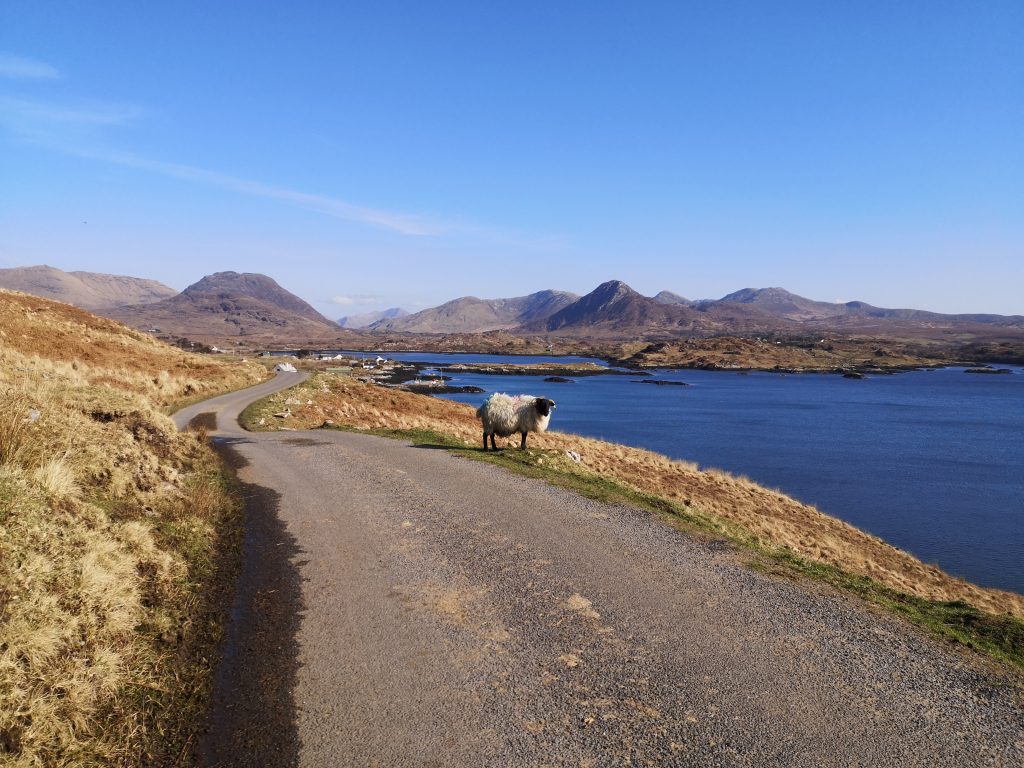
When finally we make it to the bottom of the hill, we park outside Ocean’s Alive Visitor Centre, already desolate-looking, having presumably lost most of its visitors to the pandemic. Walking alongside the hill for a few hundred metres, we see no clear path or trail. Eventually we come upon a laneway which penetrates the hill and start our ascent. After scaling a gate and attracting the attention of several sheep who stopped munching grass to observe us, we realise that we are in a field belonging to the wild-looking farmer. In the distance is a barn and as we approach we see his distant form, a speck of yellow highlighter on rusty tin. The sheep watch us wide-eyed as we make our way past them surreptitiously, over another gate, finally onto Letter Hill. The climb itself is not too steep or difficult, but we are not prepared for the marshiness of the fields or the harshness of the wind. Having not brought proper hiking equipment, our progress is slow, squelching through grass muddy from the weeks of relentless rain that had preceded our visit. But we are comforted by the deep sense of isolation on the hill. On the summit, we take in the views which are just as astonishing as those on Diamond Hill. Below us is Letterfrack Pier which opens out onto the Atlantic where the locals farm fish. Behind us again are the Twelve Bens, impressive in the early-Spring light. The sun shines brightly and we sweat beneath our coats and hats. We are soon uncomfortable due to our lack of proper equipment and the freezing harsh wind and decide to head back across the farmer’s gate, past the curious sheep and past the pier to the car where we sit and gulp down water from our bottles, glad to be back in the car and even gladder to have made the excursion, despite its trials. Little do we know that this would be our last such adventure for some months. That night, as we rest in front of the fire, a nationwide lockdown is announced and the world rotates on its axis.
Finding ourselves trapped in Connemara, away from civilisation, seems fortunate, considering the circumstances. The view from our front window is idyllic. Sheep roam the garden and the sea is visible, being less than one hundred metres away. The garden fauna becomes a constant source of entertainment – lambs leap wildly into the air and grown sheep jostle one another out of the way at feeding time. Nothing excites us more than the diurnal return of a trio of ducks – two male, one female – who frequent the garden in the mornings to eat the food intended for the sheep and to bathe in their drinking pail. One of the male ducks is more aggressive than the other: head bowed, bill pointed forward, he charges forward at his competitor, forcing him to waddle brusquely away from food or the lone female. Throughout these displays of male machismo and bravado, the female duck remains resolute and unmoved, apparently unimpressed by his antics.
Also visible from our window is a set of three small islands. The middle of these is the smallest; one tiny jut of land flanked by two larger masses. The island on the right seems barren and unoccupied, but the ruins of a house and a monastery are visible on the leftmost island. We can see animals moving on this island, although from this distance, it is impossible to discern whether they are sheep or cows. Sometimes we see Eugene, Helen’s brother-in-law and the farmer who tends to our sheep, taking a boat to this island in the distance to feed the animals. It becomes a fantasy of ours to cross over to these islands. Later, we discover that they are Helen’s private property, and with that revelation, our fantasy dissipates, but never our fascination with the islands, which, depending on the tide level, become more visible and seem to be constantly moving closer to the shore.
A few hundred metres down the road from our cottage stands a hotel, with acres of land. It has been shut since our arrival and its grounds became part of our extended garden. There is a white sandy beach in our playing area, less than a ten-minute walk from the gate of the nearby hotel. The grounds of this hotel are host to more ducks, as well as a set of particularly vicious geese. Some weeks into our stay, we are treated to the sight of twelve or fourteen ducklings beneath a bridge in the hotel grounds. Sandra is thrilled by their appearance – she insists that they resemble small, floating marble-cakes. They bobble around in the water, bouncing off one another and their mother who seems frustrated in her efforts to keep them close together. As the weeks pass, the ducklings become increasingly energetic and they zoom forward in the water inexplicably. Undeterred by obstacles, they hop onto toadstools and other plants, continuing their sprint in a way that seems resonant of a video game. Different species of butterfly wander the empty grounds, most notably Orange Tip butterflies which circle our heads each time we go running. We pay attention not to crush caterpillars making their steady progress from one side of the road to the other. As the weeks pass and we enter May, small dragonflies appear, darting around us and flashing neon blue in the early summer light.
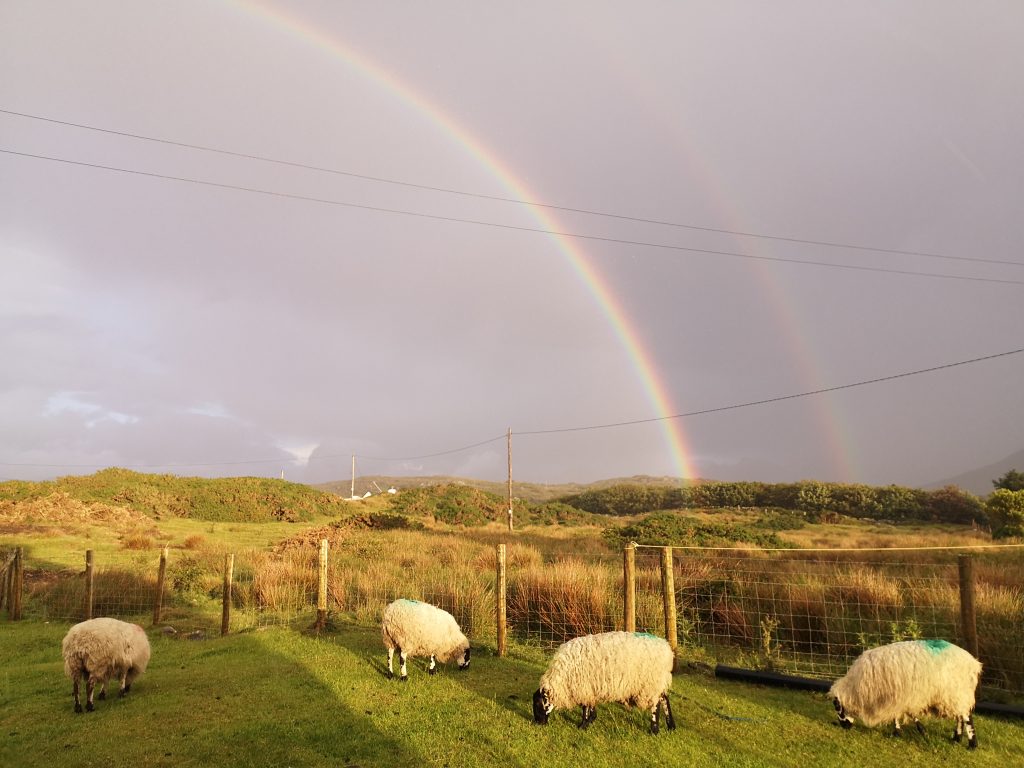
Before writing his more canonical works, the Nobel Laureate Samuel Beckett, who had played a small role in the French Resistance movement, fled the Nazi-occupied city of Paris and spent years lying low in Roussillon, a small town in the South of France. Despite his friendship with the artists Henri and Josette Hayden and his acquaintance with an Irish woman ‘Miss Beamish’ as she was commonly known in Roussillon,[1] he and his partner Suzanne remained essentially isolated from civilisation. During this time, Beckett wrote his fiercely repetitive, and hilariously funny novel Watt, in an attempt to maintain his sanity. I can hardly claim that my experience in this cottage mirrors Beckett’s, but there are some similarities I cannot but note – the repetitiveness of the days, the sense of ‘waiting’ for a global event to come to an end, the general unease, the physical separation from family members and friends. Perhaps, I should have stayed in the city, volunteered and done something for those affected with the virus, at my own personal risk. But would that really have been brave? I then would have risked complete isolation and illness for an indeterminable length of time, as well as infecting those I love. Contrary to what I feel, it is paradoxically more courageous to remain isolated now, away from infection. Even on the rare chance one of us contracts the virus here, we have few close contacts and can remain isolated. At least I am writing more, I tell myself, in an attempt to justify the powerlessness and impotence I feel.
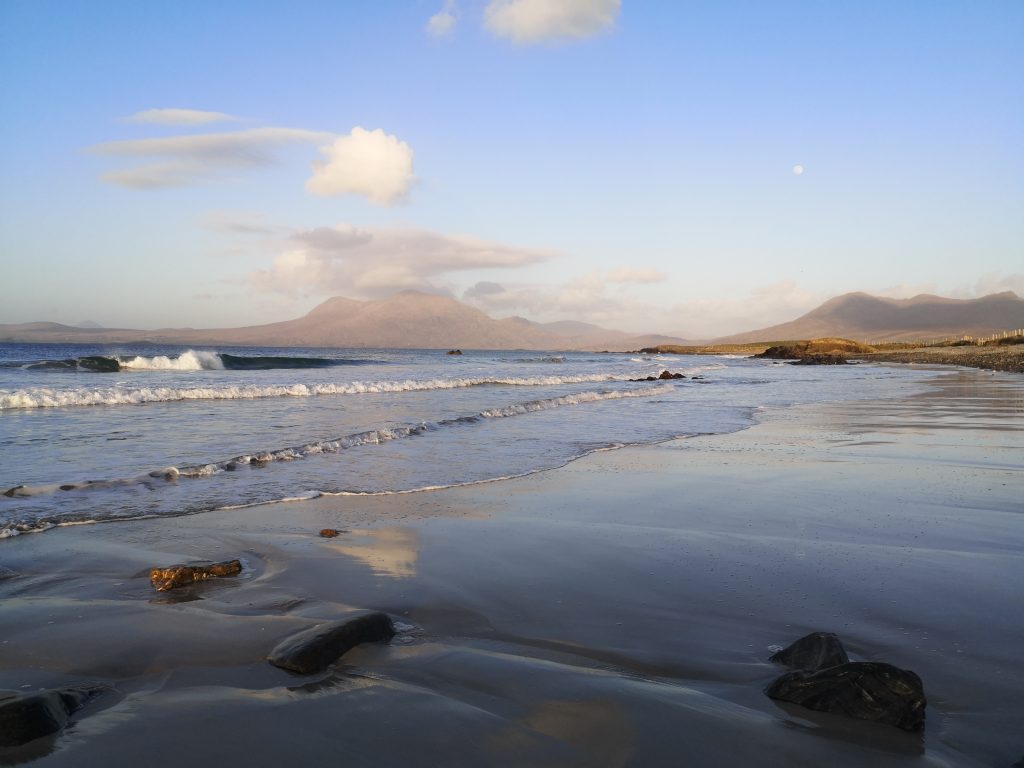
Countless poets and writers have written about the sea; describing its vicissitudes and its ever-undulating tapestry. For us, during our stay, it represents a sense of renewal and it gives us hope for an end to these strange times. The strand is never the same as the day before, and each day something different is washed ashore: weeds, crabs, shells, stones. One day in early May, we are surprised by the sight of what seems to be hundreds, perhaps thousands of tiny jellyfish dispersed along the length of the beach. A week later, a fully-grown jellyfish is deposited on the sand. Crabs also begin to appear and the strand is strewn with their corpses. Coming across a huge empty shell, we turn it over and are greeted by the smell of rancid fish. At the end of each day the sea reclaims its load, sweeping it back into the vastness. Once, when the tide is low, we find what looks like the remains of a different type of crab, half-buried in the sand; however, when we get close it comes alive and scuttles across the strand. It is unusual looking with a long trunk-like appendage, almost like a giant stinger on its face. Researching this creature back at the cottage, we discover that it is a masked crab, or Corystes cassivelaunus. What we had believed to be a trunk are two intertwined antennae that the crab uses to take in oxygen when buried in sand. Perhaps this masked creature will be safer than us during this pandemic, siphoning up pure oxygen from the ground, unexposed to contagious aerosol particles.
The strand is bisected by a piece of land that juts forward aggressively. At low tide, we walk easily around this ridge. At high tide, however, there is only one way to continue our walk and this is by scrambling up the cliffside and back down the other side. On the top, we find not the grassy patches we expect, but layers of shells compressed into the rock’s sediment. Over years, sea snails and mussels attached themselves to these enormous edifices, clinging on with all their might, until one day, they were fossilised into the stone itself.
On both the Easter and May Bank Holiday weekends, a different kind of fossilised creature is deposited on the strand: city-dwelling holiday-homers. We see them for the first time as we walk the usually uninhabited beach. They are fat, monolithic creatures, sporting cowboy hats and dressed in unseasonable attire. They drive cars registered to other counties and we make sure to keep our distance, our isolation having made us increasingly paranoid of the outsider.
Sandra had admitted to me that it was the dream of most German travellers to spend an extended time in Connemara. She had been unimpressed by the trees and hills surrounding my home town in Wicklow, which she had claimed, not inaccurately, resembled the countryside of her hometown in the Saarland. The western sea captivates her and she frequently interrupts our walks in order to photograph the water and the surrounding landscape. She is always in search of maritime souvenirs and stops to inspect anything that arouses her curiosity. After a month of daily walks across the strand, we have amassed an impressive collection of seashells. It seems a waste not to do anything with them and so, on our next walk, Sandra brings a small plastic bag which she fills with sand and takes back to the cottage. We pour the sand into a whiskey glass, half-filling it, then arrange the shells on top. On these shells, we place a tea candle. Our new candle-holder is given pride of place in the front windowsill, where it will remain for the rest of our stay.
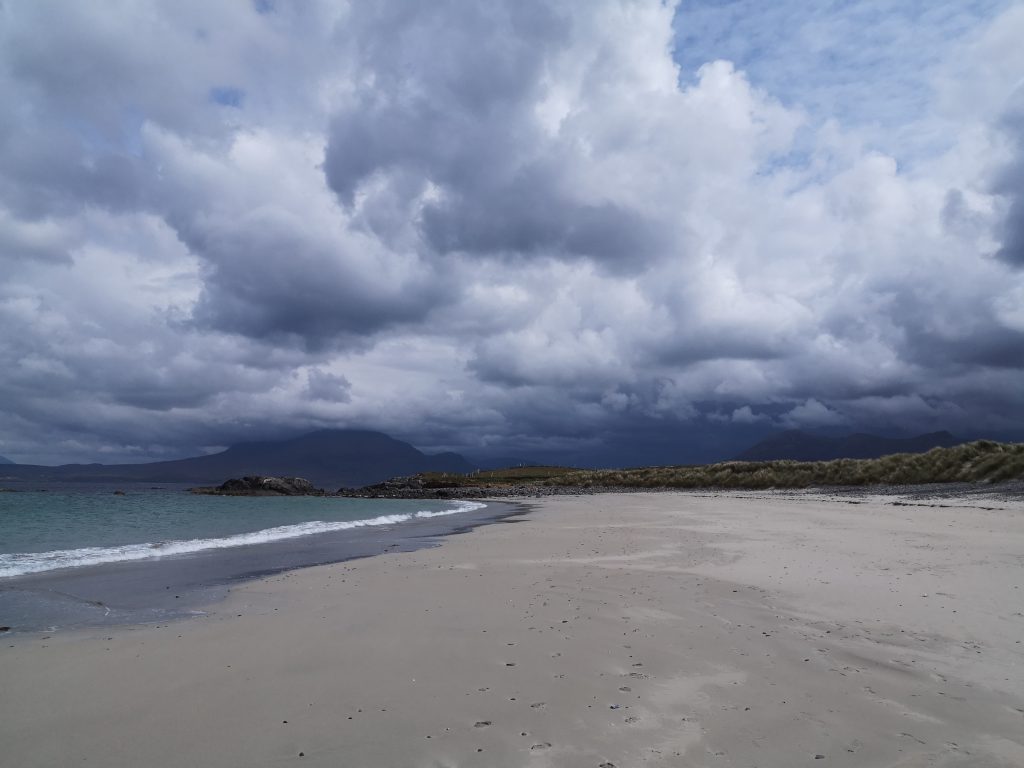
As the evenings lengthen, we often walk to the closest strand of beach to watch the sunset. As the sun sinks, the sky is coloured a transcendental orange and the sea is pastel blue – almost chalk-like. Looking across the Atlantic, the distant mountains are shrouded in cloud and fog and the island ruins are haunted and beautiful. Low clouds spill over the distant peaks, a divine and misty waterfall. The vision is ethereal and we are moved.
On the eve of my twenty-seventh birthday we watch a full-flower supermoon rise from the back porch. It arrives later than predicted, almost an hour later, but it is worth the wait. The sky is filled with light as it rises above the cottage. We try to photograph the scene, but it is almost impossible to capture because of the contrast between the brightness of the moon and the darkness of the sky. We hear distant noises from our neighbours who seem unaware of the spectacle created by this natural phenomenon. Otherwise the night is still.
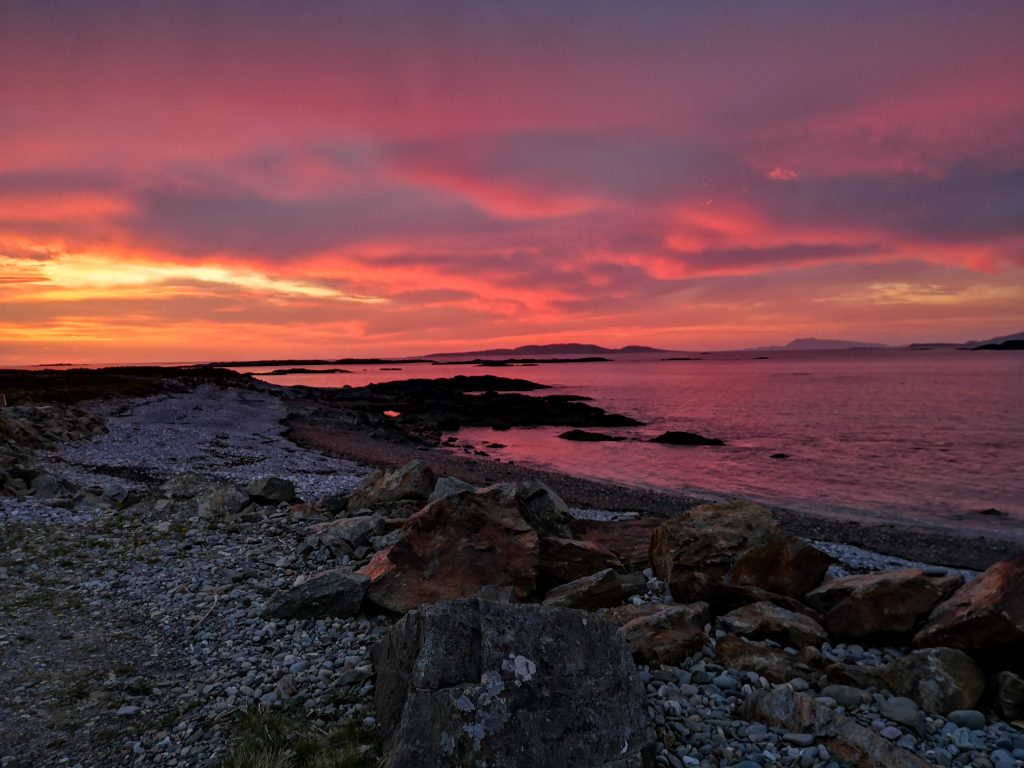
The storm hits us in late May. As I carry bags of turf down the driveway back to the cottage through howling wind, I realise that I am truly living the authentic Connemara experience. While outside, I look for the sheep, which I have not seen since the storm began. They are huddled together against one side of our cottage, sheltering from the elements. Sandra watches my slow progress from the window, the wind tousling me as I stagger up the driveway, my steps laboured and clumsy. The electricity is gone and we have no idea when it will return. There is no phone reception and our laptops are switched off in an effort to conserve their batteries. Helen deposited the bags of turf at our driveway in the early hours of the morning. She arrives sometime later, bearing gifts – emergency candles, flashlights, a flask of boiling water and chocolate. She doesn’t know when the electricity will be back, but she hopes by the afternoon. There is little we can do for the day but sit at the window, watching the storm. Like the sea, it brings a sense of renewal – as if the violence and destruction it symbolises will make way for newer, better beginnings.
The next day we go on our now-habitual walk through the grounds of the hotel. We are met with scenes of devastation. Branches ripped from trees are strewn across the grounds and the trail is cloaked by large deciduous leaves. Nothing rustles in the hedges as we walk by and we are unaccustomed to such stillness. A few days before the storm, we had been awoken early by the piercing, rhythmic shrieks of a seagull outside our window. In our sleepy delirium we had vowed vengeance against this bird, but today, as we walk along the strand, we are horrified to stumble upon the carcass of a seagull strewn before us, rotting in the early summer sun. Its wings are spread in the sand as if crucified and its chest is rotted through or has been ripped open. What remains of its insides are exposed to the harsh salty winds.
One morning in early June, a week before we are due to leave Connemara, I wake early and wheel the electric radiator with me from the bedroom to the kitchen. Although the sun is shining, the cottage is still cold and I plug in the radiator beside the kitchen table. It is not long before Sandra follows me into the kitchen. A blanket from the bed is draped over her shoulder.
‘Is the kettle boiled?’ she asks. Too tired to say anything, I just nod and she swishes her way to the counter. Our mornings are spent working and writing and we breakfast when the sun reaches the back porch, usually around eleven. We prepare breakfast together, with the intention of sitting outside on the garden furniture. A small portion of the back garden had been cut off from the sheep by wire fencing. Balancing bowls and plates on one arm, I open the door, only to discover that one of the lambs, going very much through an adolescent phase, had leaped the fence and shat on our rubbery, porous doormat. As I chase away the lamb, Sandra picks up the mat to inspect it. A large piece of excrement falls through its holes onto the concrete step, radiating fresh heat. We take the breakfast back inside, deciding it best to eat indoors.
Later that evening, when we are finished working, we set off on an extended walk past the hotel grounds to the white strand beach. On arrival we note two separate sets of tracks in the sand: one from a dirt bike motorcycle and one from a quad. As we descend the path to the beach, we hear the roar of an engine. Behind us the dirt bike appears and launches itself into the sand. An old woman is walking her dog on the strand. At the noise, the dog tries to tear away from her, jerking the leash violently, wrenching her neck and shoulder. She falls in pain, still clinging to the dog’s leash. The man’s dramatic entrance has left his bike stuck deep in the sand. The engine will not start, and he cannot escape our rebukes. A grown man, he looks like a child being scolded by a teacher for a wrongdoing. It seems like karmic retribution as we watch him wheel his broken bike back the way he came, his face downcast.
Still shaken from the encounter, we continue our walk along the beach. The tracks in the sand reminds us that man likes to drive over the face of the earth, defecating on it the same way the lambs shit on our doorstep. But the sea will erase the tracks. The tide is low and we walk to the end of the strand. The sea has receded further than usual, and we continue walking past our usual point of return, emerging onto an unusually barren, rocky terrain. It feels like we are standing on the set of Mad Max or some other post-apocalyptic movie: our playground of the apocalypse. We continue to follow the rocks, careful not to slip or step into seawater puddles and are led up a small cliff. From here, the entire strand and its environs are visible. The early summer sun still burns brightly, although it is now late, and my anger dissipates, making way for a kind of awe. The brown, almost barren landscape that we had entered in March had transformed radically. The Tolkien-esque mountains, black and imposing when we arrived, are now covered in greenery. To me, it signifies hope. I look back down at the rocks from which we ascended. There is nobody else left on the beach and there is a profound stillness. The only noise is the lapping of the sea. The tide is rising and the water begins to erode the tracks. As we descend from our perch, we take comfort knowing that the pandemic too, will someday be swept away into the annals of history. The tracks are almost gone now and will be replaced by whatever the approaching sea carries.
[1] James Knowlson, Beckett’s official biographer, notes that her real name was the more ‘impressive’ Anna O’Meara de Vic Beamish.
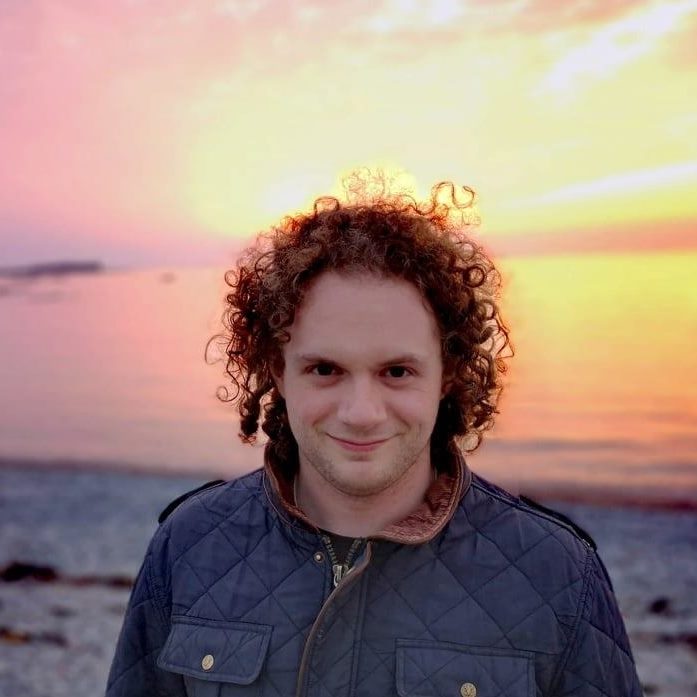
Shane O’Neill is the recipient of a literature Agility Award from the Arts Council of Ireland. His fiction has been broadcast on RTÉ Radio One and his writing is published in Paper Lanterns, Púca Magazine, The Honest Ulsterman and Sonder Magazine.
